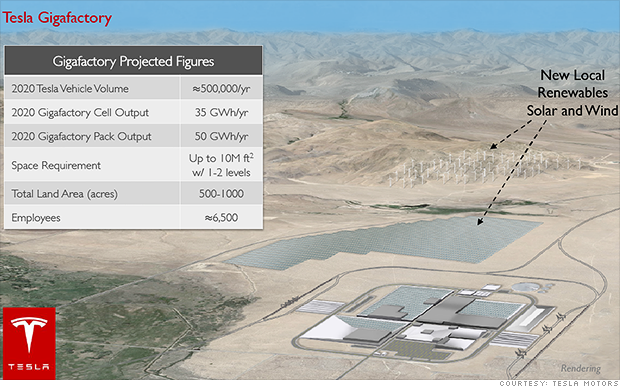 On September 4th, Nevada Governor Brian Sandoval and Tesla Motors CEO Elon Musk announced that Sparks, Nevada has been selected as the official site for the Tesla Gigafactory—a $5 billion dollar and 10 million square-foot lithium battery factory. The state’s package of incentives is worth up to $1.3 billion—the 13th largest governmental giveaway in U.S. history. Upon completion in 2017, the Gigafactory will not only be the largest lithium-ion plant in the world, but it will also be powered by solely renewable energy. This is a substantial step in the direction of a mass-market affordable electric car for two reasons. First, the size of the factory will provide economies of scale that will drive down the production costs between 30-40%, which will in turn lower the car’s price tag. In fact, an estimated 500,000 cars will be produced between 2017 and 2020. Second, the site will eliminate one of the largest environmental criticisms of electric cars: although they emit less carbon dioxide during consumption than their gas-powered counterparts, the production of each battery creates a whopping 10,000-40,000 pound carbon debt, depending on where the battery is produced. Tesla’s goal is to lower the carbon footprint of battery manufacturing by making the Gigafactory a net zero energy site through the use of a combination of geothermal, wind, and solar energy. In fact, estimates show that the site could realistically produce more energy than it needs in the long run, as seen in this analysis. Nevada will also yield a high return on investment with this deal. According to the Office of Economic Development, Nevada’s GDP is expected to increase by 4%, and economic output is expected to jump by 20%. Tesla’s substantial tax breaks legally require that they make a $3.5 billion investment in Nevada over 10 years. In addition, an estimated 22,000 jobs will be produced over 20 years of the project, which is invaluable to a state that currently has the 4th highest unemployment rate. This mutually beneficial legislation truly has the potential to pave the future of the automotive industry.
On September 4th, Nevada Governor Brian Sandoval and Tesla Motors CEO Elon Musk announced that Sparks, Nevada has been selected as the official site for the Tesla Gigafactory—a $5 billion dollar and 10 million square-foot lithium battery factory. The state’s package of incentives is worth up to $1.3 billion—the 13th largest governmental giveaway in U.S. history. Upon completion in 2017, the Gigafactory will not only be the largest lithium-ion plant in the world, but it will also be powered by solely renewable energy. This is a substantial step in the direction of a mass-market affordable electric car for two reasons. First, the size of the factory will provide economies of scale that will drive down the production costs between 30-40%, which will in turn lower the car’s price tag. In fact, an estimated 500,000 cars will be produced between 2017 and 2020. Second, the site will eliminate one of the largest environmental criticisms of electric cars: although they emit less carbon dioxide during consumption than their gas-powered counterparts, the production of each battery creates a whopping 10,000-40,000 pound carbon debt, depending on where the battery is produced. Tesla’s goal is to lower the carbon footprint of battery manufacturing by making the Gigafactory a net zero energy site through the use of a combination of geothermal, wind, and solar energy. In fact, estimates show that the site could realistically produce more energy than it needs in the long run, as seen in this analysis. Nevada will also yield a high return on investment with this deal. According to the Office of Economic Development, Nevada’s GDP is expected to increase by 4%, and economic output is expected to jump by 20%. Tesla’s substantial tax breaks legally require that they make a $3.5 billion investment in Nevada over 10 years. In addition, an estimated 22,000 jobs will be produced over 20 years of the project, which is invaluable to a state that currently has the 4th highest unemployment rate. This mutually beneficial legislation truly has the potential to pave the future of the automotive industry.
Everyday economics from the University of Puget Sound
